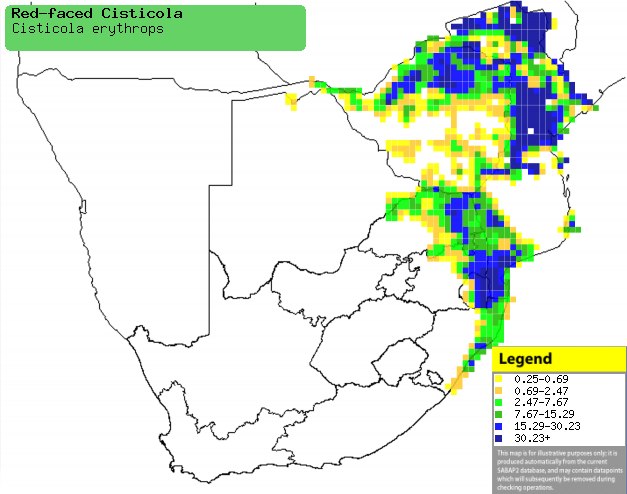|
Cisticola erythrops (Red-faced
cisticola)
Rooiwangtinktinkie [Afrikaans]; Harudeve (generic term for
cisticola or prinia) [Kwangali]; Timba (generic name for cisticolas and
warblers) [Shona]; Roodmasker-graszanger [Dutch]; Cisticole à face rousse
[French]; Rotgesicht-zistensänger [German]; Fuinha-de-faces-vermelhas
[Portuguese]
Life
> Eukaryotes >
Opisthokonta
> Metazoa (animals) >
Bilateria >
Deuterostomia > Chordata >
Craniata > Vertebrata (vertebrates) > Gnathostomata (jawed
vertebrates) > Teleostomi (teleost fish) > Osteichthyes (bony fish) > Class:
Sarcopterygii (lobe-finned
fish) > Stegocephalia (terrestrial
vertebrates) > Tetrapoda
(four-legged vertebrates) > Reptiliomorpha > Amniota >
Reptilia (reptiles) >
Romeriida > Diapsida > Archosauromorpha > Archosauria >
Dinosauria
(dinosaurs) > Saurischia > Theropoda (bipedal predatory dinosaurs) >
Coelurosauria > Maniraptora > Aves
(birds) >
Order: Passeriformes > Family: Cisticolidae
> Genus: Cisticola
Distribution and habitat
Occurs patchily across sub-Saharan Africa, in West Africa
and from Ethiopia through southern DRC and Zambia to southern Africa. Here it
locally common, preferring tall, moist grassland in marshes, along watercourses
and reedbeds; it may also occupy dense vegetation on dry slopes.
|
 |
|
Distribution of Red-faced cisticola in southern Africa,
based on statistical smoothing of the records from first SA Bird Atlas
Project (©
Animal Demography unit, University of
Cape Town; smoothing by Birgit Erni and Francesca Little). Colours range
from dark blue (most common) through to yellow (least common).
See here for the latest distribution
from the SABAP2. |
Food
It eats a variety of insects, doing most of its foraging
low down in the undergrowth. The following food items have been recorded
in its diet:
Breeding
- The nest (see image below) is oval-shaped with a side entrance, built of
leaves and dry grass secured with spider web, with an outer shell of living
leaves. A soft plant down lining is added by the female during incubation.
It is typically incorporated into the foliage of a herb, shrub, forb or
small tree, usually less than half a metre above ground.
- Egg-laying season is from October-March, peaking from about
December-February.
- It lays 2-4 eggs, which are incubated mainly by the female for about
12-16 days.
- At first the chicks are brooded by the female, while the male regularly
brings her and her young food. They usually stay in the nest for about 14-16
days.
Threats
Not threatened.
References
-
Hockey PAR, Dean WRJ and Ryan PG 2005. Roberts
- Birds of southern Africa, VIIth ed. The Trustees of the John Voelcker
Bird Book Fund, Cape Town.
|
